My pupils really started to BUG me: Action research on a Year 11 exam technique
The year 10 science mock exams in 2018 showed our pupils often made simple mistakes and struggled structuring some of their extended answers. This article looks at two approaches to help improve our pupils' exam technique as they moved into year 11.
About the Author
Alan is a Science Teacher at AWS and specialises in A-level Chemistry at BC 6th Form. Alan has led serval Teaching and Learning Action Research Groups. Research interests include Working Scientifically Skills, Scientific Modelling, Questioning, Climate Change Education and use of Technology in Education.
My pupils really started to BUG me: Action research on a Year 11 exam technique
Introduction
Why don’t they just read the flipping question!?!? I have found myself exclaiming this to myself many times when marking exam questions, however it felt like a regular occurrence when marking the 2019 cohorts’ GCSE mock papers at the end of year 10. This was a shared feeling across the department. The pupils often knew the content but were either making silly mistakes, not answering the question fully, or structuring their answers poorly. Analysis of the 2018 chemistry GCSE exam papers showed that our foundation tier pupils performed poorly on extended answer questions (although in line with national), however our higher tier pupils actually performed noticeably worse than the national average. As our 2019 cohort moved forward into year 11, it was important that as a department we implemented some strategies to help our pupils progress in this area. This article looks at briefly at two strategies: the BUG technique and using Model Answers.
Strategies
The BUG Technique
This is a strategy introduced by my head of department to help formalise how pupils annotate exam questions. In the past I had always instructed pupils to “underline key words” or “highlight the important information”, but on reflection, I was not always explicit on what they should be annotating. The BUG technique gave us a systematic way to highlight the question and also the opportunity to clearly model how we would use the technique. It stands for Box, Underline, Go over.
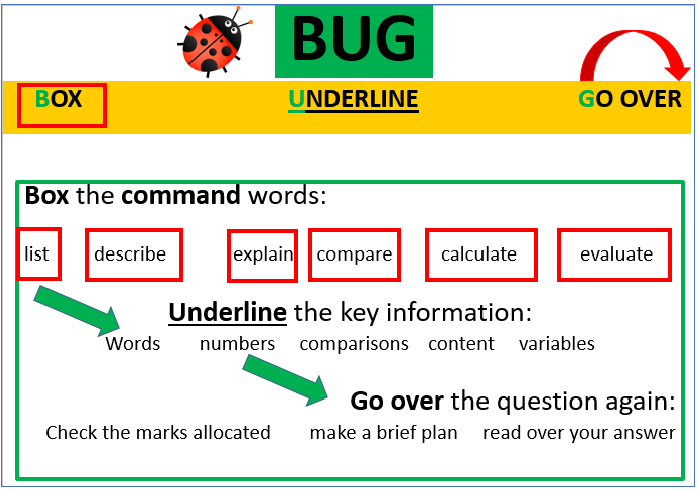
Model Answers
Model AnswersClosely linked to the BUG technique is the idea using Model Answers to help pupils structure their writing. In Chemistry, I have always found that pupils struggle with particular questions about structure and bonding. I have used model answers in the past with groups but by combining it with the BUG technique it allowed pupils to use the information in the question to help make a plan for answering this style of question. Below is an example of a BUG question with a plan and a Model Answer.
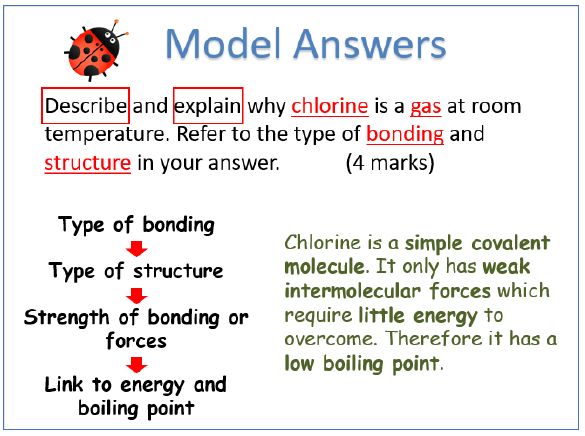
Combining the Two
Combining the TwoOne of our other priorities as a department was to improve the long-term retrieval of content taught in year 10. In January 2019 my head of department tasked us with coming up with a homework plan specifically targeting the paper 1 content. I chose to focus on the BUG technique and use of Model Answers on level 2 extended answer questions. By focusing on level 2 questions it could be used with both foundation and higher pupils. Each week the pupils had a question to answer on a different paper 1 topic, we would BUG the question together and use it to help make a brief plan to help them structure their answer. At home, they then had to write their answer independently. In addition, they had to mark an example answer on the same question that I had written for them. The example answer provided a useful starting point for them however always contained parts that were incorrect. Back in the classroom, the pupils would feedback on my example answer and we then used the mark scheme to self-assess their own answer and make improvements.
Below is a summary of the homework approach to improving extended answers.
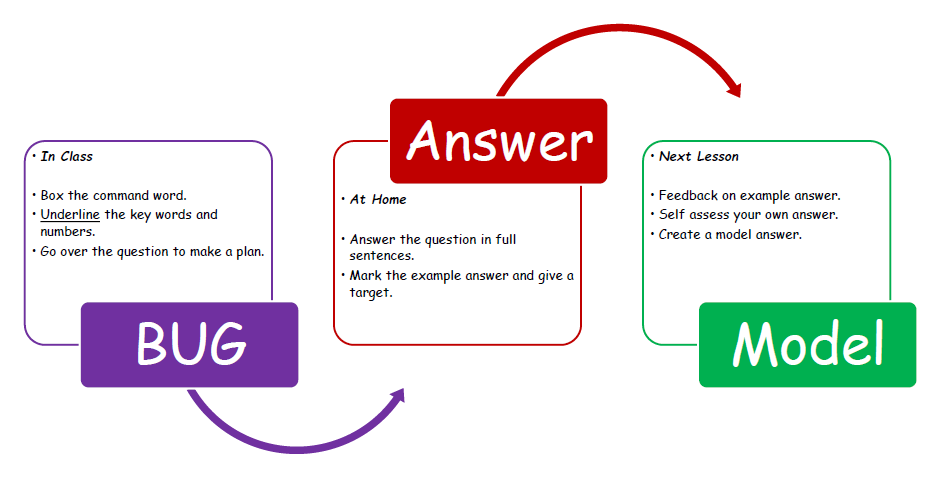
Below is an example piece of homework.
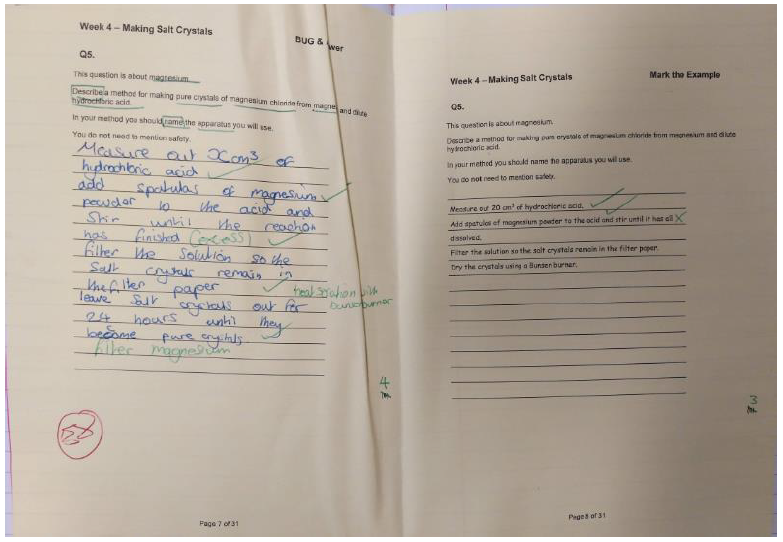
Impact
Anecdotally I could tell when I looked at my pupils' extended answer books that they were getting higher marks on these questions compared to in year 10. I also believe they were able to transfer this skill across to answering questions on paper 2 content. Across the board their paper 2 mock exam results were much higher than their paper 1 results. It was noticeable when marking the papers that more pupils were using the BUG technique. Even those who did no or little annotation of the exam questions appeared to have benefitted with a better understanding of how to structure their answers. The exam results help to back up this anecdotal evidence.The figure below shows the marks awarded for two similar 6 mark questions on a practical method.
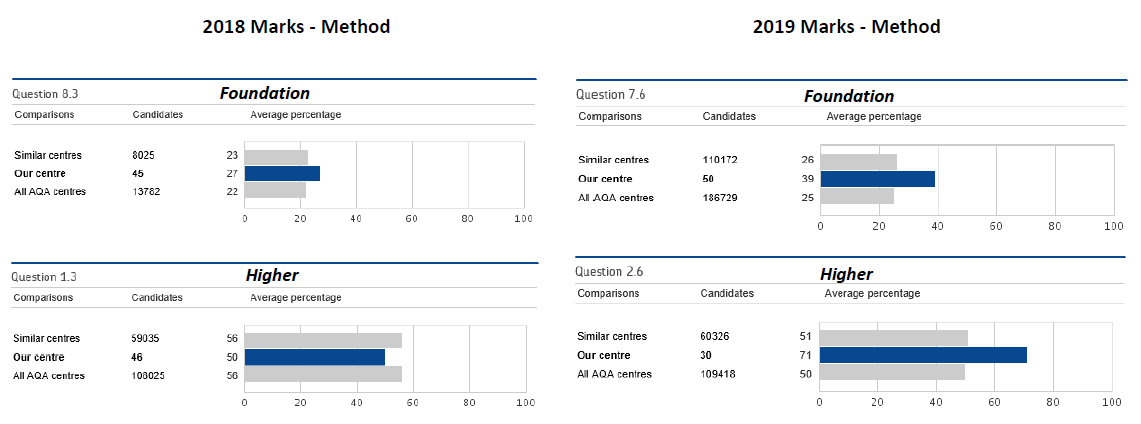
This shows an increase in the number of marks achieved by both foundation and higher tier pupils. Moreover, both groups of pupils achieved well above the national average in 2019. A similar trend was also seen in evaluation questions although the 2019 evaluation question appeared more challenging for all groups. Pupils also achieved above national average on a variety of other extended answers over a range of topics that we focused on with the Model Answers homework.

Reflection
The 2019 cohort achieved above national average in all of their science papers and in many cases exceeded our predicted grades. Many different aspects will have contributed to their excellent exam results, most importantly the pupils’ own hard work. Reflecting on these two strategies I observed that pupils were making fewer silly mistakes when answering questions and were able to better structure their responses to extended answer questions. The biggest impact was seen for pupils sitting the higher tier paper where they moved from below national average in 2018 to substantially above national average in 2019. Both strategies fit in with recent guidance reports published by the Education Endowment Foundation. The 2019 “Improving Literacy” report recommends breaking down writing tasks and explicitly teaching planning strategies. Modelling the BUG technique with the pupils gives them this explicit instruction. Using the example answers as part of their homework and then creating a model answer using the mark scheme, gave pupils the opportunity to monitor and review their writing.The BUG & Model Answer homework strategy can be used again with the 2020 cohort to aid long term retrieval of paper 1 content in the run up to their exams. The BUG technique can be implemented across all year groups in our day to day lessons. If the pupils are trained and well-practiced in using the technique by year 10, it will allow us to focus on more specific styles of questions or other areas of development. I hope that future cohorts will BUG me as much as the 2019 group did!
Last modified on Monday, 23 September 2019 14:06
Download attachments:
Login to post comments

